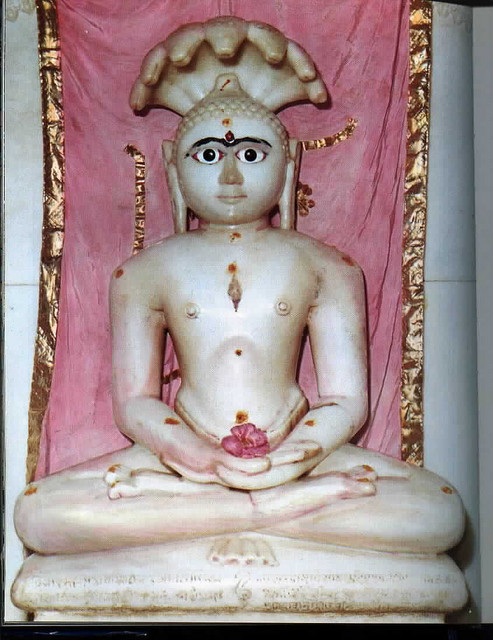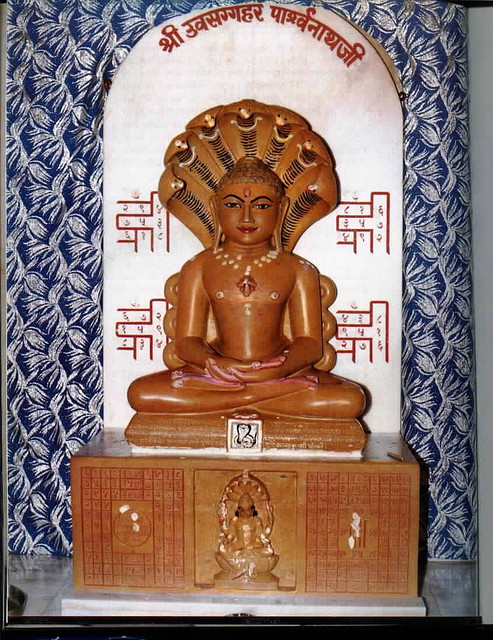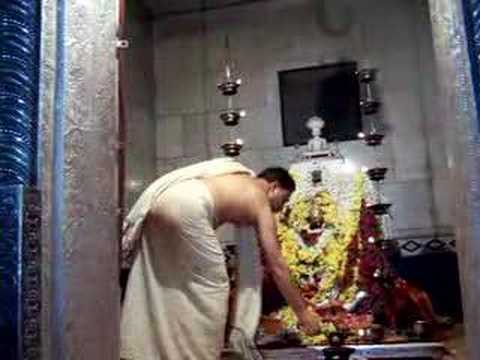Idol Installation in a Jain Temple
Even today several new Jaina temples are being constructed. As seen earlier, the cult images are made for installation in new temples. An image, unless it undergoes the ceremony of installation through a series of rituals, is not qualified for worship in a Jaina temple. The ceremony lasts for three to five days of general worship of the five great Beings of Jainism, and rituals connected with auspicious beginning and fertility rite, and five days of ritual and theatrical depiction of five great events of the life of Tirthankara. This ceremony depicting the five events of conception, birth, renunciation, enlightenment and nirvana is called Pancha Kalyanak (or Pancha Kalyana) Pratistha Mahotsava, the great celebration of installation through the five auspicious events. Usually the main image to be installed (mulanayaka or main deity) is taken out in a procession, if it is too large then a small bronze image (vidhinayaka) is used for that purpose.
At first Pooja is offered to the five great beings, namely Arhat, Siddha, Acharya, Upadhyaya and Sadhu and their qualities. These beings and their qualities are depicted in the form of a large diagram painted on the floor. On the first day the Tirthankara image is taken out in procession; on the second day the people who were going to play the roles of the father of the Jina and the Indras are appointed and worshipped. Afterwards, a patch on the ground is selected and cleaned. On this patch, boundaries are marked by lines drawn with red and white powder and inside a square border a swastika is drawn and worshipped. Later, the ritual participants dressed as Indras and Indranis come one after the other and dig out clay from the worshipped patch. This clay is filled in eight earthen pots which are placed in eight sections of a lotus-shaped diagram painted on the floor. Near each pot a silver replica of one of the eight auspicious marks is placed. In these pots five different kinds of grains are sown. The ritual is called Mrtikanayana (bringing of the clay), and Ankuraropana (sowing of the seeds). This ancient fertility ritual is interpreted by the pandit, the conductor of the ritual, as representing the increase in wealth and fertility on earth before the birth of the Tirthankara.

After these preparatory rituals begin the actual ceremony of the five events. For the event of conception, a glass casket is installed on the stage. Inside the casket a yantra is placed by the man who acts as the father of the Tirthankara. The woman acting as the mother touches the yantra with her fingers. Then the father gives a bath to the image and places it inside the glass casket and closes it. The glass casket now represents the womb of the mother of the Tirthankara. The image inside represents the embryo and the whole event is representative of the Tirthankara coming into the womb of his mother. The image of the tirthankara are wrapped in a white cloth to indicate that it was in the embryo stage.
On the second day the mother of Tirthankara plays by a lady dressed as a queen, shown lying on a couch attended by girls dressed as heavenly maidens. She is shown, one after the other, the 16 dream images painted on a cardboard. These paintings indicated the 16 auspicious dreams of the Tirthankara mother. On the third day the event of the birth of the Tirthankara takes place. The ritual image is taken out of the glass casket and handed over to the couple who acts as Indra and lndrani. They place it on a decorated elephant and bring it in a procession to an artificial tower which represents the mythical mount Sumeru. The image is placed on top of the tower, post-birth bath is given to it by the people representing Indra and other Gods. Later, the image is brought back and placed inside a cradle surrounded by various toys.

On the fourth day the image is given princely clothes and is coroneted on a royal chair in front of a painted theatrical curtain depicting the palace. After the ceremony of coronation, the image is placed inside a palanquin and is carried in procession outside the town Here it was placed under a large Asoka tree or a platform. Around the platform an enclosure of white cloth is put up. Inside the enclosure the princely clothes are removed and some cloves are fixed on the head with sandalwood paste. Later, these cloves are scraped by the pandit indicating that Tirthankara had given up clothes and had plucked out his hair to renounce the world. After that the pandit inscribes the letters of the alphabet on various parts of the image, showing that tirthankara had entered the path of knowledge. All this is done in the seclusion of the enclosure. Finally the image is placed inside a bucket and covered with clothes and carried away secretly by a ritual assistant. The last act indicates that Tirthankara had disappeared in the forest and had undertaken the path of wandering alone as a monk. The image is brought back to the temple where it was installed on a high stool under a tree. On one side of the image a small peacock-feather broom and, on the other, a water pot are placed. This represents the event of renunciation and monk hood of the Tirthankara. Then the image, representing monk hood, is carried on the head by a devotee to the house of a layman who had invited the monk for a meal. The man stops in front of the house where stood a couple to invite the monk for a meal. They have pots filled with water and covered with coconuts. The image is worshipped by the host couple by uttering the words of invitation and by circumambulating the image three times. Then the image is brought inside the compound and is placed on a high seat. In front of the image are kept many silver plates filled with food. The worshippers fill up spoons of food and keep it in front of the image in the posture of feeding and empty the spoons in a plate in front of it. The image is then brought back to the temple. At night, again in seclusion, the pandit places the image inside an enclosure and in front of it lit a lamp and uttered many mantras. This secret ritual is meant to impart knowledge to prepare for the event of enlightenment. On the morning of the next day, a jaina guru performed the most crucial ceremony of opening of the eyes. This indicated the opening of the eyes and enlightenment of Mahavira. The image was placed on top of tapering towered structure, samavasarana, the divine preaching hall created by the gods for the preaching of the Tirthankara immediately after his enlightenment. This also represented the first sermon to the universe.
On the last day, the event of nirvana is commemorated. In the early morning the pandit cleans a patch of ground, draws a swastika on it and places a marble tile over it. On the tile, he constructs a miniature pyre from sandalwood pieces which he lights with a burning piece of camphor. This indicates that Tirthankara had attained the final liberation, nirvana, and that his material body was cremated. Now the image is placed inside a glass casket placed over a miniature mountain representing siddhashila under three umbrellas. The most important part of the ritual of idol installation as practiced today is the event of enlightenment represented by the act of touching the pin to the eyes to indicate the opening of the eyes.
The Tirthankara image which has undergone the ritual of installation thus becomes qualified for worship in the temple. The ritual of opening of the eyes is also performed over the large main image in the temple.


